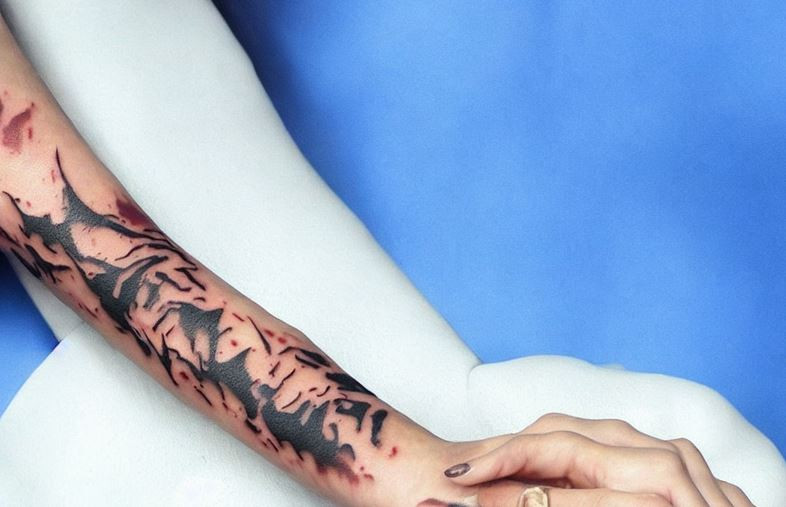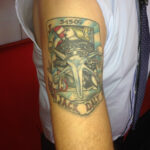Yes, you can often tattoo over a small scratch, but it’s essential to assess the scratch and consult with your tattoo artist; At tattooat.com we’re here to guide you through this and other considerations for getting inked. A minor scratch might not prevent you from getting your tattoo, but understanding the situation thoroughly ensures a safe and satisfactory tattooing experience. Explore tattoo cover-up options, tattoo aftercare guidance, and skin preparation tips at tattooat.com!
1. Understanding Scratches and Tattoos
To understand whether you can tattoo over a scratch, it’s essential to know how scratches and tattoos affect your skin:
1.1 What is a Scratch?
A scratch is a superficial injury that affects the outermost layer of your skin, known as the epidermis. According to Healthline, scratches typically don’t penetrate into the deeper layers of the skin, such as the dermis.
1.2 What is a Tattoo?
A tattoo involves injecting ink into the dermis, which is the layer of skin beneath the epidermis. This process creates a permanent design. Because the ink is deposited deeper than a surface-level scratch, tattoos can sometimes be done over minor scratches.
2. Factors to Consider
Before deciding whether to tattoo over a scratch, consider these factors:
2.1 Size and Depth of the Scratch
Is the Scratch Small and Superficial?
If the scratch is small and only affects the surface of the skin, it’s generally safe to tattoo over it.
Is the Scratch Deep or Large?
Deep or large scratches may require more time to heal. Tattooing over such injuries can lead to complications.
2.2 Location of the Scratch
Is the Scratch in the Tattoo Area?
If the scratch is within the area you plan to tattoo, it’s essential to evaluate it carefully.
Is the Scratch on a High-Movement Area?
Scratches on areas that experience a lot of movement, such as joints, may take longer to heal and could affect the tattoo.
2.3 Age of the Scratch
Is the Scratch Fresh?
Fresh scratches are more prone to infection and irritation. Tattooing over a fresh scratch is generally not recommended.
Is the Scratch Healing?
If the scratch is in the process of healing, it may be more suitable for tattooing, but only if it’s not too deep or inflamed.
2.4 Risk of Infection
Potential for Infection
Any break in the skin carries a risk of infection. Tattooing over a scratch increases this risk.
Maintaining Hygiene
Proper hygiene and aftercare are essential to prevent infection when tattooing over a scratch.
3. Tattooing Over a Scratch: The Process
If you and your tattoo artist decide to proceed with tattooing over a scratch, here’s what to expect:
3.1 Consultation with Your Tattoo Artist
Importance of Professional Advice
Always consult with your tattoo artist to get their professional opinion on whether it’s safe to tattoo over the scratch.
Assessing the Skin
Your tattoo artist will examine the scratch to determine its depth, size, and overall condition.
3.2 Preparing the Skin
Cleaning the Area
The area around the scratch must be thoroughly cleaned with an antiseptic solution.
Shaving (If Necessary)
If there is hair around the scratch, your tattoo artist may shave the area to ensure a clean surface.
3.3 Tattooing Procedure
Using Sterile Equipment
Your tattoo artist will use sterile needles and equipment to minimize the risk of infection.
Applying the Tattoo
The tattoo will be applied carefully over the scratch, with attention to any sensitive areas.
3.4 Aftercare Instructions
Following Aftercare Guidelines
Your tattoo artist will provide specific aftercare instructions to ensure proper healing.
Keeping the Area Clean
Keep the tattooed area clean and moisturized to prevent infection and promote healing.
4. When to Avoid Tattooing Over a Scratch
In certain situations, it’s best to avoid tattooing over a scratch:
4.1 Deep or Infected Scratches
Deep Scratches
If the scratch is deep and penetrates the dermis, it’s best to wait until it has fully healed. Deep scratches increase the risk of infection and can affect the tattoo’s appearance.
Infected Scratches
Never tattoo over an infected scratch. The infection needs to be treated and fully resolved before getting a tattoo.
4.2 Scratches Near Sensitive Areas
Areas Prone to Irritation
Scratches near sensitive areas, such as the eyes or mouth, should be allowed to heal completely before tattooing.
Areas with High Friction
Avoid tattooing over scratches in areas with high friction, as this can delay healing and affect the tattoo.
4.3 Medical Conditions
Skin Conditions
If you have skin conditions like eczema or psoriasis, tattooing over a scratch can exacerbate these conditions.
Compromised Immune System
People with compromised immune systems should avoid tattooing over scratches to minimize the risk of infection.
5. Potential Risks and Complications
Tattooing over a scratch can lead to several risks and complications:
5.1 Infection
Bacterial Infections
Bacteria can enter the skin through the scratch, leading to infections.
Symptoms of Infection
Symptoms include redness, swelling, pain, pus, and fever. Seek medical attention if you experience these symptoms.
5.2 Scarring
Increased Risk of Scarring
Tattooing over a scratch can increase the risk of scarring, affecting the appearance of the tattoo.
Keloid Formation
In some cases, tattooing over a scratch can lead to keloid formation, which is an overgrowth of scar tissue.
5.3 Delayed Healing
Slower Healing Process
The scratch can delay the healing process of the tattoo, requiring more time for the skin to recover.
Compromised Tattoo Quality
Delayed healing can also compromise the quality and appearance of the tattoo.
5.4 Ink Rejection
Potential for Ink Rejection
The skin may reject the tattoo ink in the area of the scratch, leading to uneven coloring or fading.
Uneven Tattoo Appearance
Ink rejection can result in a patchy or inconsistent tattoo.
6. Aftercare Tips for Tattooing Over a Scratch
Proper aftercare is crucial when tattooing over a scratch to minimize risks and promote healing:
6.1 Keeping the Area Clean
Washing the Tattoo
Gently wash the tattooed area with mild, fragrance-free soap and warm water.
Frequency of Washing
Wash the tattoo 2-3 times a day to keep it clean and prevent infection.
6.2 Moisturizing the Tattoo
Applying Moisturizer
Apply a thin layer of fragrance-free moisturizer to keep the skin hydrated.
Types of Moisturizer
Use moisturizers recommended by your tattoo artist, such as Aquaphor or specialized tattoo balms.
6.3 Avoiding Irritants
Sun Exposure
Avoid direct sun exposure, as it can damage the tattoo and delay healing.
Tight Clothing
Wear loose, breathable clothing to prevent friction and irritation.
6.4 Monitoring for Infection
Checking for Symptoms
Regularly check the tattoo for signs of infection, such as redness, swelling, or pus.
Seeking Medical Attention
If you notice any signs of infection, seek medical attention immediately.
7. Alternatives to Tattooing Over a Scratch
If tattooing over a scratch is not advisable, consider these alternatives:
7.1 Waiting for the Scratch to Heal
Allowing Time for Healing
The best option is often to wait until the scratch has fully healed before getting the tattoo.
Benefits of Waiting
Waiting ensures that the skin is healthy and reduces the risk of complications.
7.2 Adjusting the Tattoo Design
Modifying the Design
Your tattoo artist may be able to adjust the design to avoid the area of the scratch.
Creative Solutions
This can be a great way to get the tattoo you want without compromising your skin’s health.
7.3 Using Topical Treatments
Applying Healing Ointments
Use topical treatments like vitamin E oil or scar creams to promote healing of the scratch.
Consulting a Dermatologist
Consult a dermatologist for recommendations on the best treatments for your skin.
8. Real-Life Examples
Consider these scenarios:
8.1 Scenario 1: Small, Superficial Scratch
Situation:
A client has a small, superficial scratch on their arm from a pet.
Recommendation:
The tattoo artist assesses the scratch and determines it is safe to tattoo over. They proceed with caution, using sterile equipment and providing thorough aftercare instructions.
8.2 Scenario 2: Deep Scratch from a Fall
Situation:
A client has a deep scratch on their leg from a fall.
Recommendation:
The tattoo artist advises the client to wait until the scratch has fully healed before getting the tattoo. They recommend using a healing ointment to promote skin recovery.
8.3 Scenario 3: Infected Scratch
Situation:
A client has an infected scratch on their back.
Recommendation:
The tattoo artist refuses to tattoo over the infected area and advises the client to seek medical treatment. The tattoo can be scheduled once the infection is fully resolved.
9. Expert Opinions
What do experts say?
9.1 Tattoo Artists’ Perspective
Importance of Assessment
Experienced tattoo artists emphasize the importance of assessing each scratch individually.
Prioritizing Safety
They prioritize the client’s safety and the quality of the tattoo over proceeding with a risky situation.
9.2 Dermatologists’ Advice
Focus on Skin Health
Dermatologists recommend focusing on skin health and allowing scratches to heal fully before getting a tattoo.
Preventing Complications
They advise against tattooing over open wounds to prevent infections and scarring.
10. Choosing a Tattoo Artist
Selecting the right tattoo artist is crucial:
10.1 Credentials and Experience
Checking Credentials
Ensure the tattoo artist is licensed and has proper certifications.
Reviewing Experience
Look for an artist with extensive experience and a portfolio of high-quality work.
10.2 Hygiene Standards
Sterile Environment
The tattoo studio should maintain a sterile environment with disposable needles and equipment.
Following Protocols
The artist should follow strict hygiene protocols to prevent infections.
10.3 Consultation Process
Importance of Consultation
The artist should offer a thorough consultation to assess your skin and discuss any concerns.
Asking Questions
Don’t hesitate to ask questions and express any concerns you may have.
11. Tattoo Styles and Scratches
Certain tattoo styles may be more suitable for tattooing over a scratch than others:
11.1 Bold, Solid Designs
Suitable for Cover-Ups
Bold, solid designs can be effective for covering up minor scratches or scars.
Even Ink Distribution
These designs allow for even ink distribution and can help camouflage imperfections.
11.2 Intricate, Detailed Designs
May Require More Precision
Intricate, detailed designs may require more precision and are not always suitable for tattooing over scratches.
Potential for Distortion
The scratch could distort the fine lines and details of the tattoo.
11.3 Watercolor Tattoos
Delicate Appearance
Watercolor tattoos have a delicate, soft appearance that may not be ideal for covering up scratches.
Fading Concerns
The ink may fade or blend unevenly in the area of the scratch.
12. Maintaining Your Tattoo’s Appearance
Long-term care is essential:
12.1 Sun Protection
Importance of Sunscreen
Protect your tattoo from the sun by applying sunscreen regularly.
Choosing the Right Sunscreen
Use a broad-spectrum sunscreen with an SPF of 30 or higher.
12.2 Hydration
Keeping Skin Hydrated
Drink plenty of water to keep your skin hydrated and healthy.
Moisturizing Regularly
Continue to moisturize your tattoo regularly to prevent dryness and fading.
12.3 Avoiding Harsh Chemicals
Limiting Exposure
Avoid harsh chemicals, such as chlorine and strong detergents, as they can damage the tattoo.
Using Gentle Products
Use gentle, fragrance-free products to clean your skin and tattoo.
13. Addressing Common Concerns
Here are some frequent questions:
13.1 Can I Use a Numbing Cream?
Consulting Your Artist
Always consult with your tattoo artist before using a numbing cream.
Potential Effects
Numbing creams can affect the skin’s texture and ink absorption.
13.2 What If the Scratch Gets Infected After Tattooing?
Seeking Medical Attention
If the scratch gets infected after tattooing, seek medical attention immediately.
Following Treatment
Follow your doctor’s instructions and keep the area clean and bandaged.
13.3 How Long Should I Wait Before Tattooing Over a Deeper Scratch?
Allowing Sufficient Time
Allow sufficient time for the deeper scratch to heal completely, typically several weeks to months.
Checking with a Professional
Check with a dermatologist or tattoo artist to ensure the skin is ready.
14. Innovations in Tattooing
Stay updated:
14.1 New Techniques
Advancements in Tattooing
Explore new techniques that minimize trauma to the skin.
Consulting Experts
Consult with experienced artists who use these advanced methods.
14.2 Advanced Aftercare Products
Specialized Products
Use advanced aftercare products designed to promote healing and prevent complications.
Researching Products
Research products recommended by dermatologists and tattoo artists.
15. Conclusion
Tattooing over a small scratch is possible, but it requires careful consideration and professional advice. Always assess the scratch, consult with your tattoo artist, and follow proper aftercare guidelines to minimize risks and ensure a beautiful, healthy tattoo.
Ready to explore stunning tattoo designs, find talented artists, and gain essential tattooing knowledge? Visit tattooat.com today! Let us help you bring your tattoo visions to life, safely and beautifully. Check out our extensive collection of tattoo ideas, artist directories, and expert articles to guide you every step of the way. Discover the perfect design and artist for your next tattoo adventure with tattooat.com.
FAQs
1. Can you tattoo over a very small, superficial scratch?
Yes, you can tattoo over a very small, superficial scratch, but it’s essential to have your tattoo artist assess it first to ensure it’s safe and won’t compromise the tattoo’s quality or increase the risk of infection.
2. How long should I wait before tattooing over a scratch?
Ideally, wait until the scratch is fully healed before tattooing. For minor scratches, this might be a few days to a week. For deeper scratches, it could take several weeks or even months to fully heal, reducing the risk of complications.
3. What are the risks of tattooing over a scratch?
The risks include a higher chance of infection, scarring, delayed healing, and ink rejection, which can affect the tattoo’s appearance and longevity. Proper aftercare is crucial to minimize these risks.
4. Will tattooing over a scratch be more painful?
Yes, tattooing over a scratch can be more painful because the area is already sensitive and potentially inflamed. Communicate with your tattoo artist about pain management strategies if needed.
5. What if the scratch is infected?
Never tattoo over an infected scratch. The infection needs to be treated and fully resolved by a healthcare professional before considering a tattoo. Tattooing over an infection can lead to serious complications.
6. Can I use a numbing cream before tattooing over a scratch?
Consult your tattoo artist before using a numbing cream, as some creams can affect the skin’s texture and ink absorption. Your artist can advise on the best approach for pain management in your specific situation.
7. What type of tattoo design is best for covering a scratch?
Bold, solid designs are often best for covering scratches, as they allow for even ink distribution and can camouflage imperfections. Avoid intricate or watercolor designs, as they may not cover the scratch effectively.
8. How do I care for a tattoo that’s been done over a scratch?
Follow your tattoo artist’s aftercare instructions meticulously. Keep the area clean with mild, fragrance-free soap, moisturize regularly with a recommended lotion, and avoid sun exposure and tight clothing to promote healing and prevent infection.
9. Should I consult a dermatologist before tattooing over a scratch?
Consulting a dermatologist is a good idea, especially if you have a history of skin conditions or if the scratch is deep or concerning. They can provide personalized advice to ensure your skin is healthy enough for tattooing.
10. What if the scratch turns into a scar? Can I tattoo over a scar?
Yes, you can tattoo over a scar, but it’s essential to wait until the scar is fully healed and matured, which can take several months. A skilled tattoo artist can assess the scar and create a design that works with the scar tissue for the best possible outcome.
 tattoo over small cut
tattoo over small cut
 tattoo on scratches
tattoo on scratches
